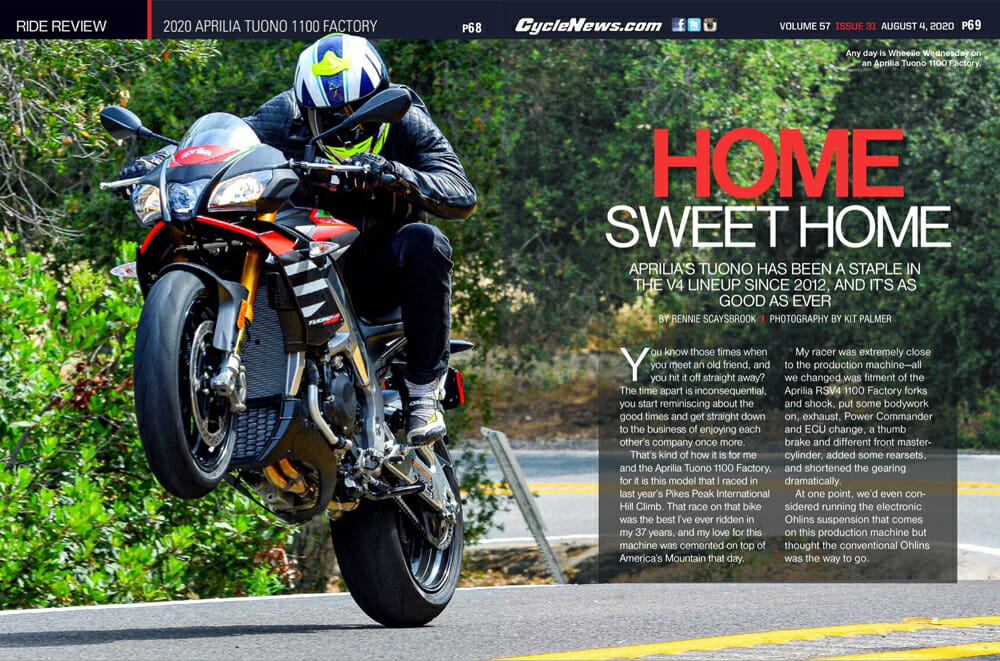Rennie Scaysbrook | August 8, 2020
Aprilia’s Tuono has been a staple in the V4 lineup for over a decade, and it’s as good as ever.
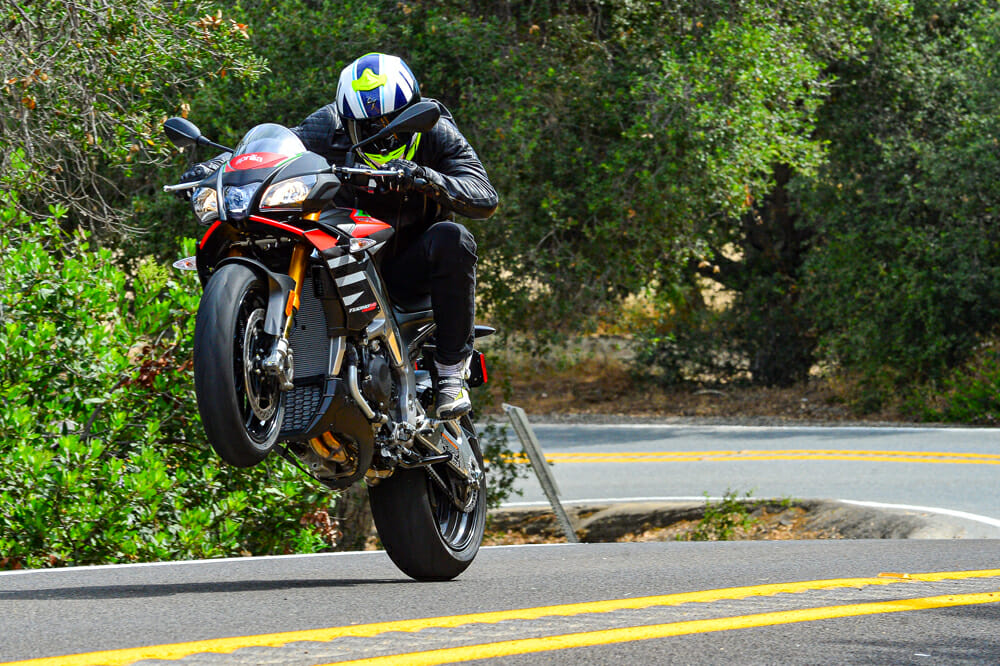 Any day is Wheelie Wednesday on an Aprilia Tuono 1100 Factory.
Any day is Wheelie Wednesday on an Aprilia Tuono 1100 Factory.
Photography by Kit Palmer
You know those times when you meet an old friend, and you hit it off straight away? The time apart is inconsequential, you start reminiscing about the good times and get straight down to the business of enjoying each other’s company once more.
That’s kind of how it is for me and the Aprilia Tuono 1100 Factory, for it is this model that I raced in last year’s Pikes Peak International Hill Climb. That race on that bike was the best I’ve ever ridden in my 37 years, and my love for this machine was cemented on top of America’s Mountain that day.
My racer was extremely close to the production machine—all we changed was fitment of the Aprilia RSV4 1100 Factory forks and shock, put some bodywork on, exhaust, Power Commander and ECU change, a thumb brake and different front master-cylinder, added some rearsets, and shortened the gearing dramatically.
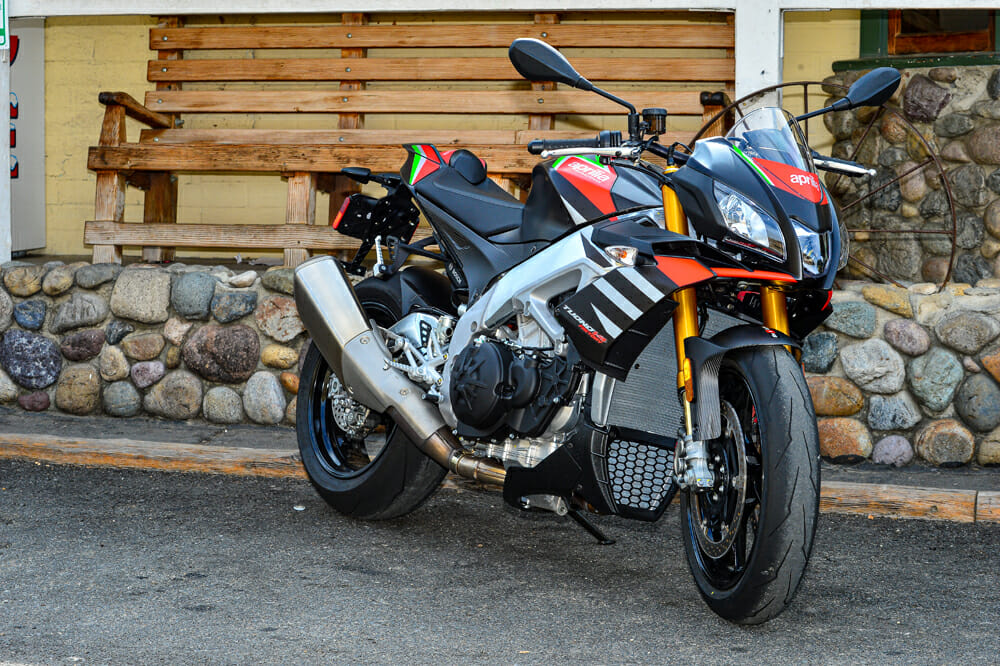 The distinctive red-green-and-black color scheme comes straight from the MotoGP racer.
The distinctive red-green-and-black color scheme comes straight from the MotoGP racer.
At one point, we’d even considered running the electronic Ӧhlins suspension that comes on this production machine but thought the conventional Ӧhlins was the way to go.
The fact that we, as a team, could make that bike go that quick was a testament to the base model and the incredible work done by Aprilia in developing what has been the gold standard for naked bikes since it debuted back in 2012.
For 2019, the Tuono 1100 Factory received the Ӧhlins Smart EC 2.0 semi-active suspension to complement one of the finest chassis ever to grace a production motorcycle. Those springers are basically what you’ll find on the Yamaha YZF-R1M (although without the pressurized fork), and the Ducati Panigale V4 S, as Aprilia manages to eek a little more life out of a design that really hasn’t changed much in the decade it’s been around.
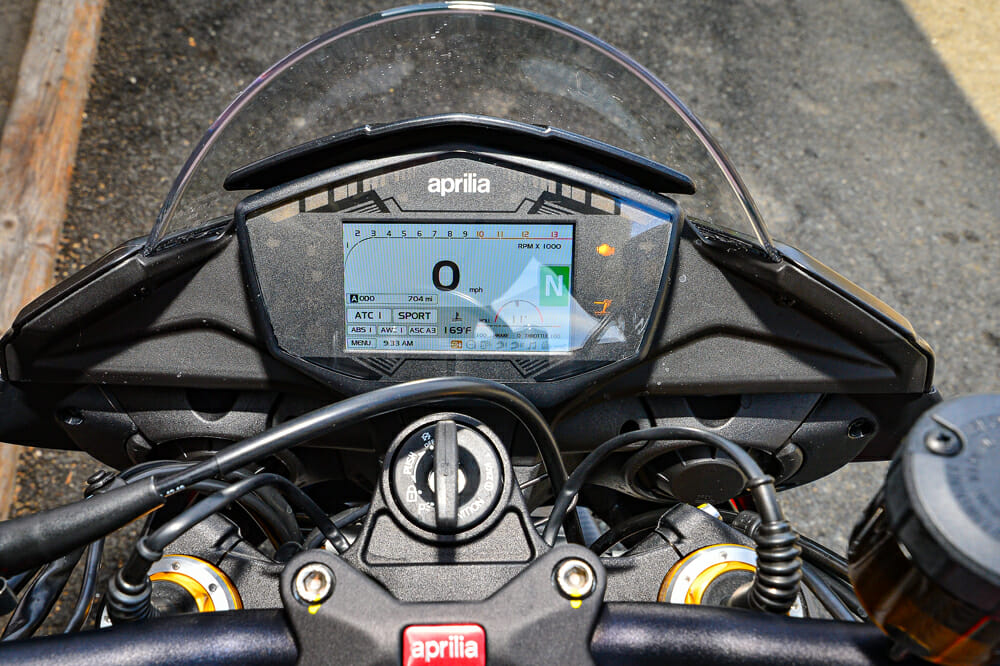 The dash is easy to use but pretty small by current standards.
The dash is easy to use but pretty small by current standards.
Interestingly, Aprilia hasn’t really needed to reinvent the wheel with the Tuono over its lifespan. If you take that first 2012 model and compare it to what’s on the screen in front of you, it’s mechanically pretty similar. The proceeding decade has seen a series of updates, including the APRC (Aprilia Performance Ride Control) electronic suite, the fitment of the 1100 motor in 2015, and steady upgrades to brakes and suspension, but the basic design is still the same.
And that’s a good thing because it shows how right Aprilia got this thing back in 2012.
It’s a folly to say the Tuono 1100 has the same motor as the RSV4 1100, because it doesn’t. There’re various intake and cylinder-head differences with the Tuono to the RSV4 that lowers the Tuono’s overall power but punches up the midrange torque, but, trust me, the Tuono is still plenty powerful enough for a street bike. Aprilia quotes 175 horsepower and 89 lb-ft of torque from its 1077cc V4, which puts it behind the Ducati Streetfighter V4 but ahead of bikes like the Yamaha MT-10.
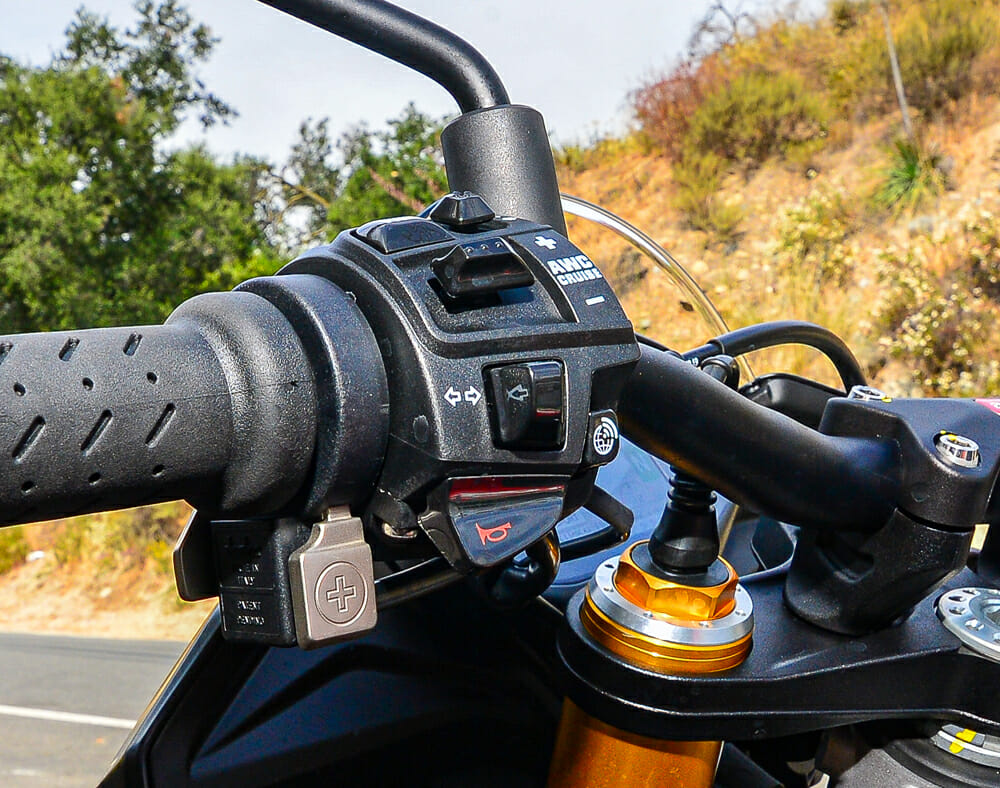 Cruise control and paddle shifts for the traction control. Aprilia did this stuff years ago.
Cruise control and paddle shifts for the traction control. Aprilia did this stuff years ago.
Knowing what I know from our Pikes Peak testing, I’d guess actual rear-wheel horsepower would be around 150-155 horsepower, so even though that seems like a fair drop to what’s quoted, that Aprilia says is crankshaft power, not rear wheel.
However, the Aprilia delivers every single one of those Italian ponies to the tire like a waiter serving you in a fancy restaurant. Of all the current big-bore/super-naked bikes on the market (and I’ve ridden all of them), the Aprilia still has the smoothest delivery of torque to the tire. The throttle connection on such a massive V4 motor is silky smooth, and there are three modes you can choose from to get the exact delivery you want.
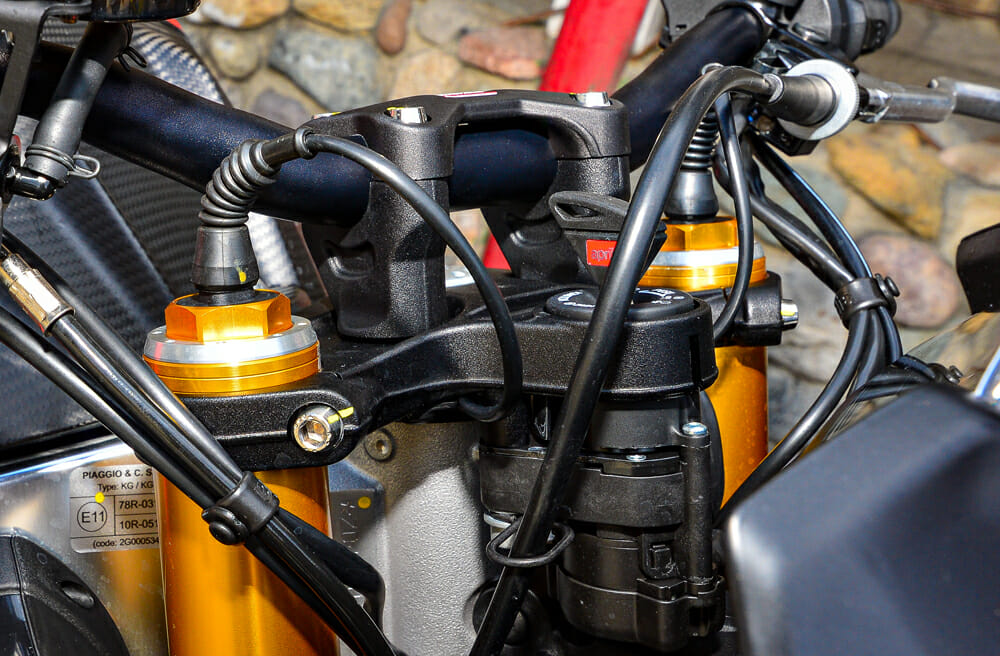 New Ӧhlins Smart EC 2.0 suspension is a step up from the non-adjustable units in 2018.
New Ӧhlins Smart EC 2.0 suspension is a step up from the non-adjustable units in 2018.
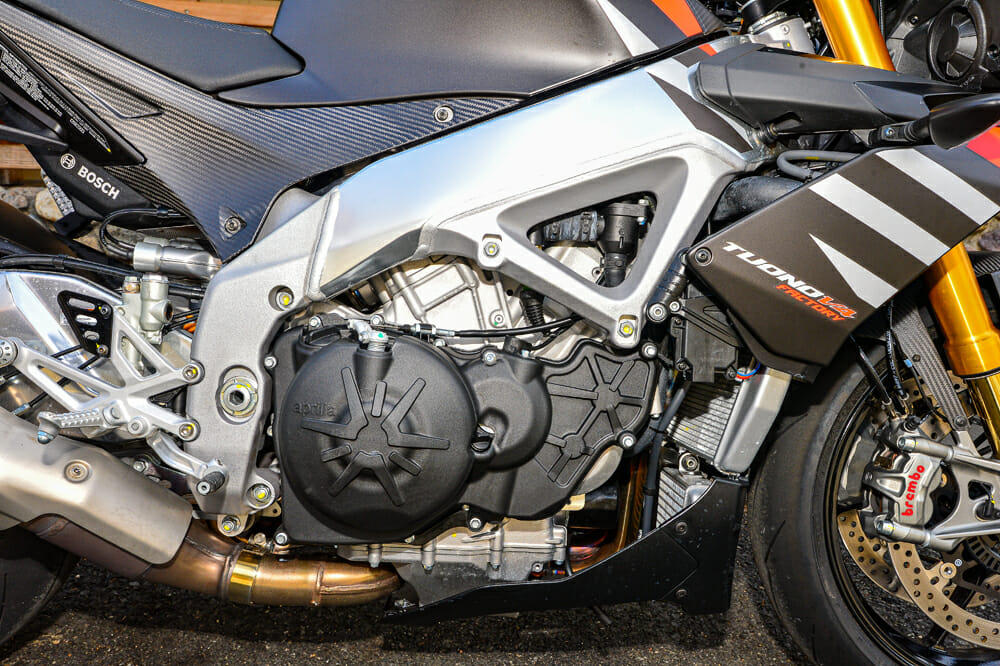 Aprilia’s beautiful powerhouse. Easily the best sounding V4 on the road, the Tuono’s lump produces plenty of poke for your Sunday ride.
Aprilia’s beautiful powerhouse. Easily the best sounding V4 on the road, the Tuono’s lump produces plenty of poke for your Sunday ride.
The street gearing is quite tall on a Tuono 1100, but the spread of power is such that you’ll not have to dance up and down on the lever to get the drive you want. You can leave the Tuono in fifth gear around town and always have power on tap, or you can go full hooligan and ride in second gear and bait the police with tire-saving wheelies.
Matched to the beautifully smooth throttle and oodles of power is still one of the best rider aid systems out there in the APRC. Aprilia was the first to use paddle shifts for traction control on the handlebar, and the new dash that was debuted in 2017 may not be the fanciest, but it’s super easy to use and read. The APRC system housed an IMU before IMU’s were even a thing, using bike position and angle to mitigate traction and wheelie control. Others have caught up and, in some cases, surpassed the Aprilia in what the electronics can do, but most manufacturers try to cram too much information and systems into the electronic suites. The Aprilia design is a case of doing it right the first time.
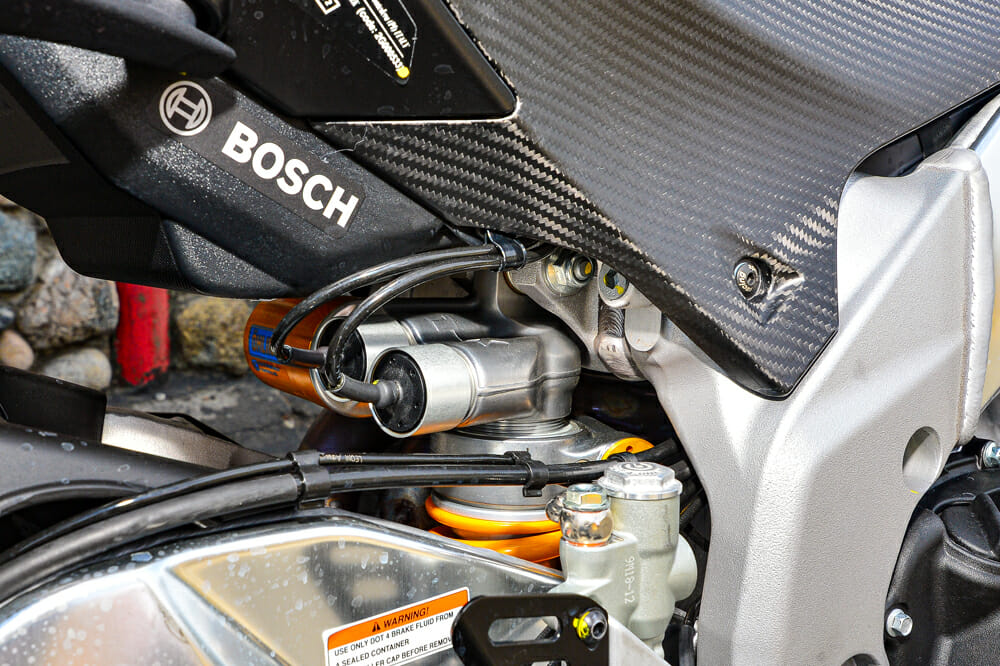 Carbon bits under the seat flank the TTX36 electric Ӧhlins shock.
Carbon bits under the seat flank the TTX36 electric Ӧhlins shock.
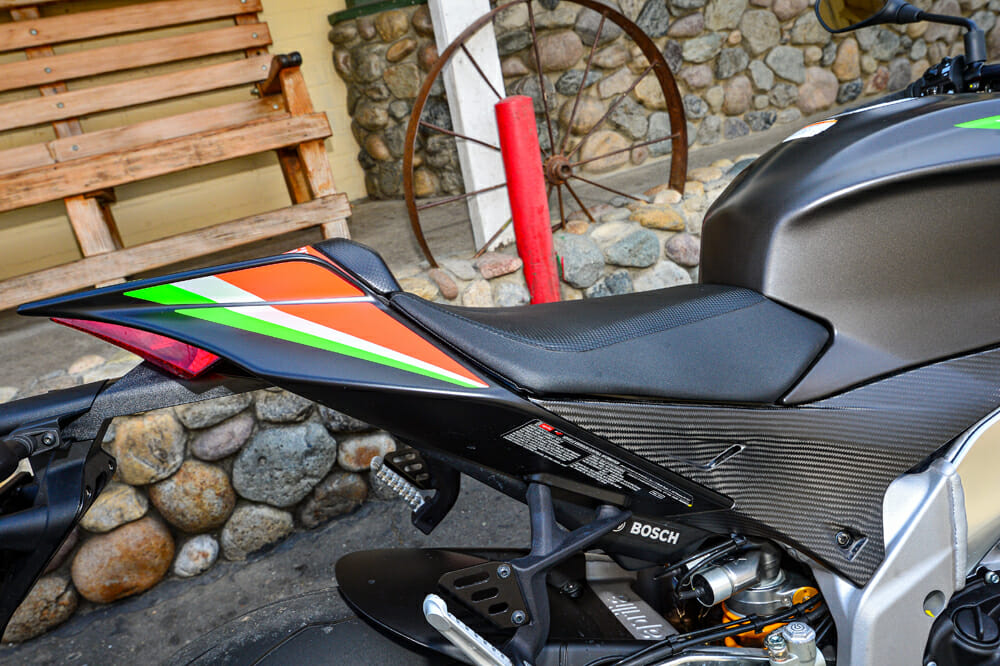 Yeah, best to go alone on the Tuono.
Yeah, best to go alone on the Tuono.
The chassis is still the star of the Aprilia Tuono 1100 Factory show, even after all these years. A certain Max Biaggi was instrumental in developing the first RSV4 chassis, which later was lightly modified for Tuono use. That made the Tuono a real stripped-back racer, arguably the first naked-bike racer, and you can feel that DNA in the 2020 edition. Coupled to the excellent Ӧhlins Smart EC 2.0 system working the NIX 30 fork and Ohlins shock, the Tuono simply adores being put on its side and powered through corners.
There are bucket-loads of feel at the handlebar, the wide stance allowing you to switch lines on a whim or take the bull by the horns and muscle it through a bumpy, snotty bend. It’s got a relatively short wheelbase at 57 inches, and the agility of the chassis is almost without peer in the big-bore naked-bike class.
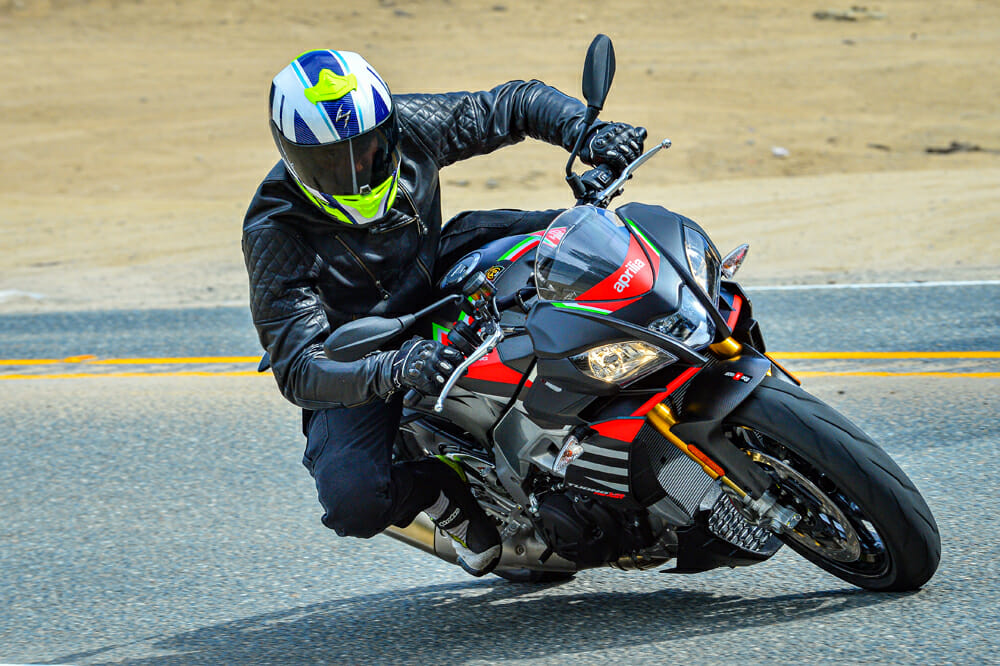 You can attack corners like a supermoto on a Tuono.
You can attack corners like a supermoto on a Tuono.
Compared to what’s on offer from Ducati, and Kawasaki with the Z H2, the ride position on the Tuono is very old school in that you sit right on top of the bike rather than in it. The Tuono could almost be called the world’s fastest supermoto, as the ride position and stance feel almost dirt bike-ish. That gives you so much freedom to move around on the Aprilia, allowing you to find an ideal ride position but also to give you room for long-distance rides. Those trips you’ll likely be doing on your own because, although there are provisions for a passenger, they are not exactly comfortable, so the rides are better left to one person.
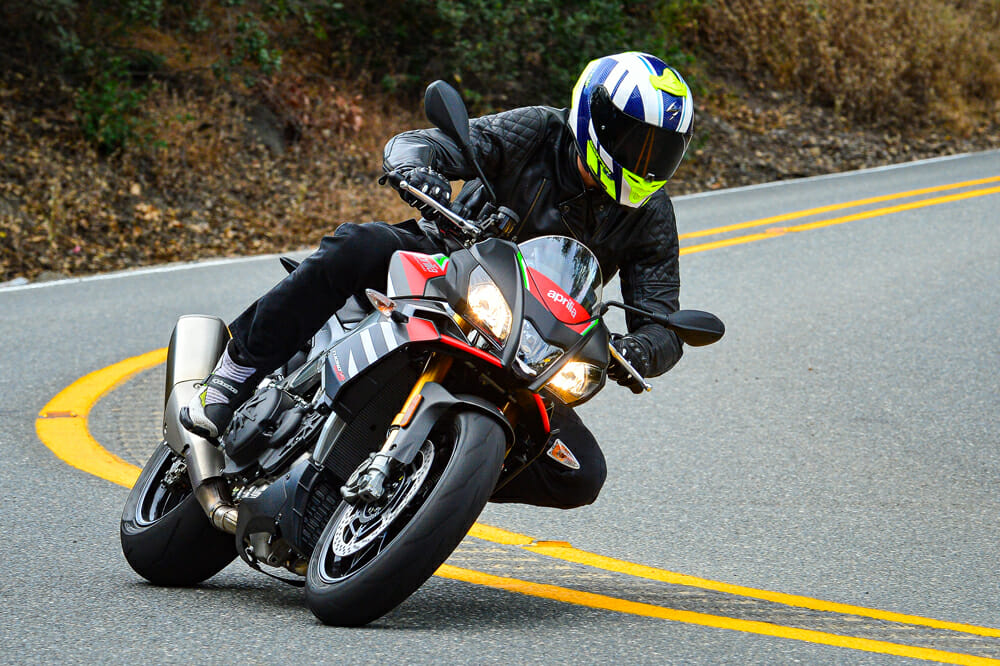 Supreme poise and agility are the hallmarks of a sporting Aprilia chassis.
Supreme poise and agility are the hallmarks of a sporting Aprilia chassis.
As awesome as the Tuono is, it’s definitely starting to feel a little dated compared to the current crop of bikes from KTM, Ducati, BMW and Kawasaki. It’s a stupendous bike, and you get decent value for money, although the game has moved on somewhat in the last few years. I would expect the Aprilia head honchos to give the Tuono a serious facelift in the next few years simply to keep up with what’s coming out from its rival manufacturers. Be that as it may, it doesn’t take away from the fact the Aprilia Tuono 1100 Factory is still an amazing naked bike. CN
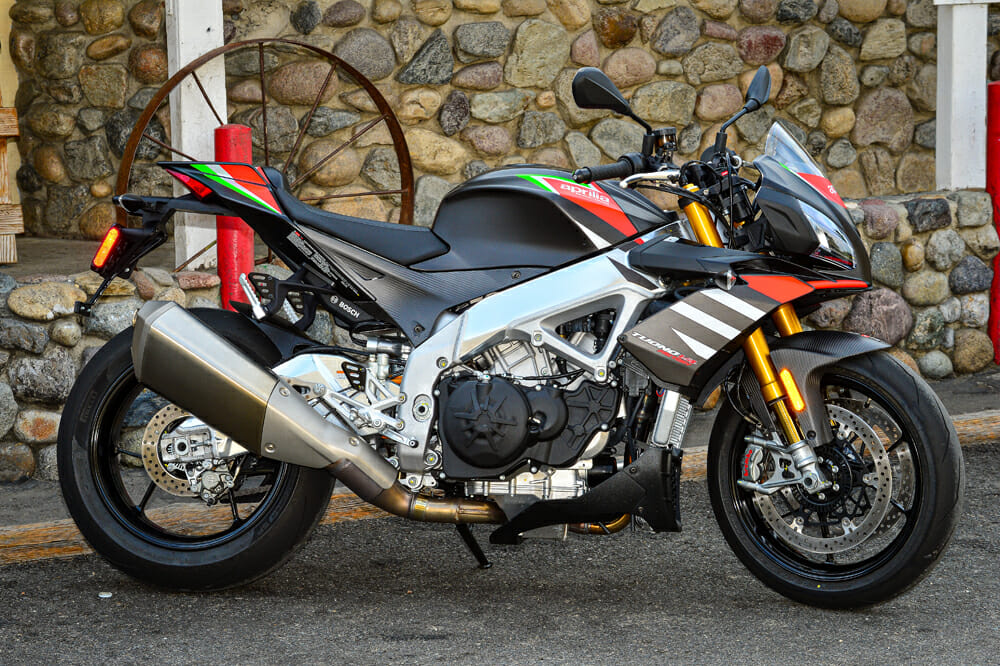
2020 Aprilia Tuono 1100 Factory Specifications
|
|
| MSRP: |
$18,999 |
| Engine: |
Liquid-cooled, Aprilia longitudinal 65° V-4 cylinder, 4-stroke, double overhead camshafts (DOHC), 4 valves per cylinder |
| Fueling: |
EFI |
| Displacement: |
1077cc |
| Bore x stroke: |
81 x 52.3mm |
| Power (claimed): |
175 hp at 11,000 rpm |
| Torque (claimed): |
89 lb-ft at 9000 rpm |
| Transmission: |
6-speed |
| Clutch: |
Wet multi-disc |
| Chassis: |
Aluminum twin-spar |
| Front suspension: |
Ӧhlins NIX fork, fully adjustable, Ӧhlins Smart EC 2.0 |
| Rear suspension: |
Ӧhlins monoshock, fully adjustable, Ӧhlins Smart EC 2.0 |
| Front-wheel travel: |
4.7 in. |
| Rear-wheel travel: |
5.1 in. |
| Front brake: |
Dual 330mm discs, Brembo M50 4-piston caliper, ABS |
| Rear brake: |
Single 220mm disc, 2-piston caliper |
| Front tire: |
120/70 ZR17 |
| Rear tire: |
200/55 ZR17 |
| Seat height: |
32.4 in. |
| Wheelbase: |
57 in. |
| Steering head angle: |
24.7° |
| Fuel capacity: |
4.8 gal. |
| Weight (wet, measured): |
471 lbs. |
